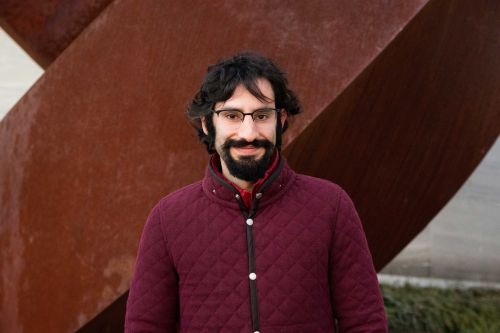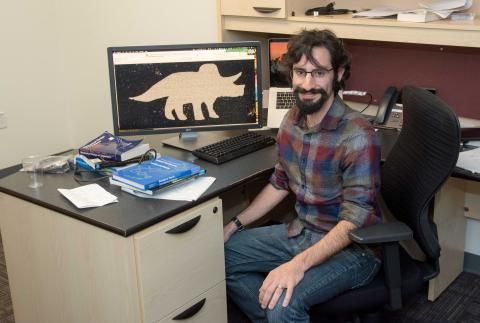
It is Friday night and Professor Daniel Cohen is giving a talk. But the location is not the usual lecture hall. Instead, the venue is a San Francisco nightclub and the subject is the history of rhinoplasty. For Professor Cohen, it is not only the science and research that is important, but also the history leading up to it.
“I care about the history of how we came to know and do the things that we do today—and I enjoy sharing those tales with the public,” says Professor Cohen, PhD, who joined Princeton as an Assistant Professor of MAE in February 2018. “A solid respect for our history is both humbling and helpful when we think about modern research avenues in bioengineering. Telling these stories is also a great way to connect with the public and explain why we do what we do.”
Take, for example, biomaterials and tissue engineering. Professor Cohen says it is both surprising and fascinating how long we have been playing this game—from 4,500-year-old Egyptian fiber scaffolds to medieval fracture fixators to modern organs-in-a-dish.
“One of the first Western manuscripts on reconstructive surgery was published over 500 years ago and the technique is still used today. It’s titled How to Make a New Nose For Someone When it is Off Entirely and the Dog has Eaten it,” explains the researcher who has presented on everything from Newton’s rivalries to pirate heists. “Apart from the incredible title, this gives a sense both of perspective and of where new innovations might lie, such as changing how we think about integrating materials with the body.”
Or consider the story of Frankenstein. Much of our modern stigma concerning bioelectricity is rooted in Mary Shelley having eavesdropped on a drunken conversation where the participants confused a species of worm with pasta. That helped inspire her to write Frankenstein, which in turn captured public sentiment and allowed for the rise of quack bioelectric medicine.
“There is some truly fantastic science hidden here, but we are still recovering from the damage caused by 19th-century pop culture and quack doctors. The fact that bioelectric phenomena are both natural and important in development and injury healing is established, but still not widely known, and together this makes for an uphill, but exciting, challenge,” says Professor Cohen. “There’s so much potential if we get it right.”
Merging insights from these histories with modern engineering, Professor Cohen’s work focuses on developing new engineering tools to control tissues. Specifically, his lab is trying to develop approaches that take advantage of the collective or ‘swarm’ nature of tissues. To understand this, it helps to think about tissues as large communities of interacting cells that exhibit complex behaviors similar to flocks of birds, crowds of people, and herds of sheep. “These communities of cells all go about their business, whether it is growing or healing, without any master controller telling them what to do and somehow it works. These behaviors can’t be explained by understanding one cell, but rather by understanding the collective,” he adds. “What makes this field fun is that everything is relevant—from how cancer works to ant colony dynamics and traffic light signaling patterns in cities.”
Once we understand how tissues behave, the obvious next step is finding ways to manipulate them. Can we herd cells in tissues like shepherds and sheepdogs herd sheep? If we could, it would allow scientists to build new tissues, heal wounds, or help understand cancer. Professor Cohen’s lab uses an approach he calls “swarm engineering” to control these cellular collective behaviors.
“The movie Babe is a great allegory for modern swarm engineering,” he says. “You have a traditional herding model that is disrupted by a non-traditional (and scrappy underdog) agent, the pig.” In the end, Babe learns how to herd sheep with the help of Farmer Hoggett.
In the case of Professor Cohen’s research, pigs and sheepdogs are replaced by bioelectric tools that can literally herd groups of living cells, or artificial objects that can infiltrate into tissue because cells mistake them for real cells.
Inspired by early 19th-century measurements of natural electric fields in skin wounds, Professor Cohen’s lab is building bioelectric microcontrollers that can give the cells within tissues a sort of compass signal and direct their motion--move left, go right, make a U-turn, swirl around. Cells are much better at this than people.

“Imagine if there were 100 people velcroed together and they all had to move left at the same time,” he says. “It would be bedlam, and with cells, they can do this in groups of 100,000 or more!”
There are many potential applications for this research. For example, electric BAND-AIDS may someday modulate how wounds heal and scars develop. Cancer is another promising area—comparing the behavior of malignant cells to healthy tissues can lead to better biomarkers for cancer.
Now take that idea one step further. What if we could control those cells from the inside-out by sneaking a secret agent into the population? To do this, we would need to create a material that tricks other cells into thinking they are cells by mimicking that secret handshake used to identify other cells. This approach, which diverges from thousands of years of biomaterials use, is exactly what the other half of Professor Cohen’s lab is working on—secret agent materials disguised with the same proteins that cells use to identify and stick to other cells.
“You basically have a ‘wolf in sheep’s clothing’ sitting in the population that tricks the tissues into responding a certain way,” says Professor Cohen. “This has exciting possibilities for controlling tissue growth and improving biomedical implant integration.”
All we have to do, he says, is find our very own Babe. Professor Cohen looks forward to the day when he can take a line from Farmer Hoggett and say: “That’ll do, cells. That’ll do.”
—Carolyn Sayre